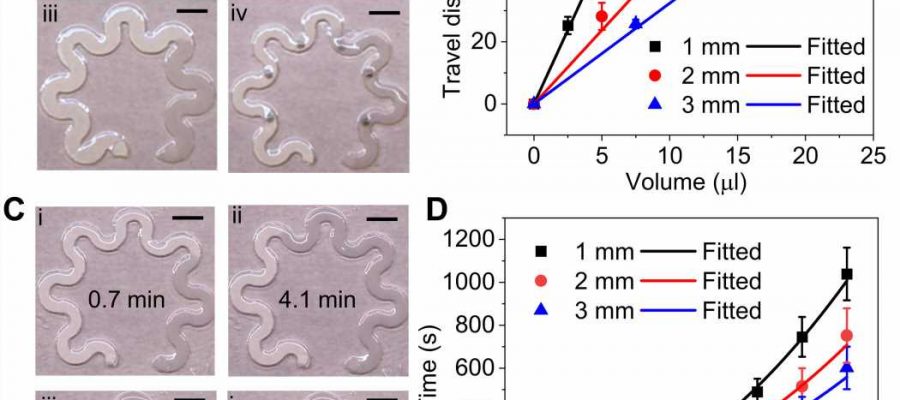
Wearable sweat sensors play an important role for clinically meaningful information relative to health and disease of individuals. While sensors mainly rely on enzymes and antibodies to achieve specific quantification of stress biomarkers, the enzymes and antibodies can degrade, contributing to poor performance. In a new report now published in Science Advances, Umesha Mogera and a team of scientists in Biomedical Engineering at the Texas A&M University, Texas, U.S., introduced a wearable plasmonic-paper-based microfluidic system to analyze sweat loss, sweat rate and its constituent metabolites, continuously and simultaneously. The team developed plasmonic sensors based on label-free surface-enhanced Raman spectroscopy to provide a chemical fingerprint for analyte identification. They showed detection sensitivity and quantification of uric acid in sweat at physiological and pathological concentrations, and facilitated accurate quantification of the parameters of interest. They engineered the wearable plasmonic device to be soft, flexible and stretchable to cover the skin without inducing chemical or physical irritations.
Measuring uric acid for disease management
Materials scientists have developed a range of physiological sensors to continuously measure physical and chemical biomarkers with applications in disease diagnosis, health monitoring and personalized medicine. Wearable sweat sensors can measure various chemicals in sweat, including electrolytes, metabolites, heavy metals, drugs and hormones to understand pathophysiological impact on the human body. The chloride concentration of sweat can provide standard diagnostic screening parameters for cystic fibrosis, while sweat glucose quantification aims for diabetes management. Similarly, uric acid is also a biomarker of cardio-renal disease and type 2 diabetes. Wearable sweat sensors typically require high sensitivity and environmental stability to accurately quantify biomarkers. In this work, Mogera et al introduced a wearable, plasmonic paper-based microfluidic or paper-fluidic system, to directly capture sweat to continuously and reliably quantify sweat loss, sweat rate and analytes in sweat, in real-time. The scientists used surface-enhanced Raman spectroscopy (SERS) to quantify the concentration of uric acid at physiologically and pathologically relevant concentrations based on the integrated plasmonic nanosensor. The team showed the modes of incorporating thin, soft and flexible plasmonic paperfluidic devices to quantify analytes of varying concentrations.

Designing the wearable plasmonic paperfluidic device
Mogera et al developed the soft, ultrathin, laminated paperfluidic device for sweat collection at the wrist, for transport, storage and real-time, label-free biochemical analyses using a portable Raman spectrometer. The device showed several advantages with several functional layers, including a double-sided adhesive, laser blocked paper microfluidic layer, plasmonic sensors and an encapsulation layer. The team used a cellulose chromatography paper with a serpentine design to serve as an effective microfluidic channel transporting excreted sweat through the porous medium without external force or inlet pressure. The serpentine design facilitated flexibility and stretchability to accommodate skin movement without interfacial stress or device degradation. Using plasmonic sensors installed at different locations of the paper microfluidic channel, the researchers quantified the concentration of analytes in sweat at different time-points using Raman spectroscopy. Notably, the black carbon double-sided adhesive blocked laser damage to prevent skin irritation during in situ Raman spectroscopy measurements. Mogera et al added a droplet of 10 µL of water and allowed the fluid to pass through the first plasmonic sensor within a minute. For the plasmonic sensors, they used chromatography paper adsorbed with gold nanorods described as AUNRs, which they synthesized, and facilitated retention onto the paper via electrostatic interactions and van der Waals forces.

Flow characteristics, plasmonic optimization and sensitivity on paperfluidic devices
The research team next quantified the sweat volume and rate via flow characteristics of the microfluidic serpentine paper sandwiched between a top encapsulation made of polydimethylsiloxane (PDMS) and bottom adhesive layers. The fluid uptake volume was linearly proportional to the paper width and liquid travel distance, for a given paper thickness. The scientists characterized the liquid kinetics of the microfluidic paper to quantify real-time sweat rate and quantified the volume and rate, which depended on the location of the device mounted on the body. Mogera et al designed and characterized the AUNR (gold nanorod) paper sandwiched between a microfluidic paper and PDMS for high sensitive detection of uric acid via SERS (surface-enhanced Raman spectroscopy). The concentration ranged from physiological and pathological concentrations in sweat for healthy people, and for those with gout and hyperuricemia. They highlighted a change in intensity following changes in uric acid concentration to confirm the capacity to quantify time-varying uric acid concentrations on the device.


Proof-of-concept and outlook
Source: Read Full Article
